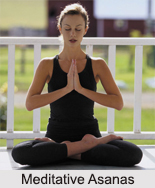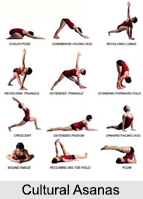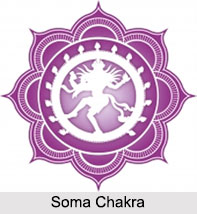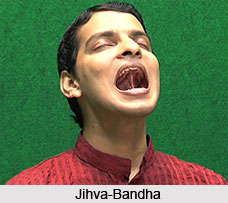Raja Yoga techniques are the most perfect means for gaining self-control, and the ultimate goal of Raja Yoga is to clear the mind from thoughts, images and desires. This is achieved through eight steps described in the first written synthesis of yoga - the Pantanjali`s Yoga Sutras: Yamas, Niyamas, Asanas and Pranayama, Pratyhara, Dharana, Dhyana and Samadhi.
All these steps have been adapted into the following series of exercises:
1. Body awareness - control through Yoga postures
2. Breath awareness - control - through Yoga breathing exercises.
3. Voluntary attention focus - control through self-discipline
4. Concentration
n
These exercises will lead to more control over the mind and body. Practiced individually, each element will be helpful, but together the program is even more powerful. Each step enhances the other. All these steps show the inner relationship among each steps and exercises. Body control facilitates breath control, and conversely, breath control facilitates body control. Similarly, body and breath control facilitate voluntary attention focus, and attention focus leads to the development of concentration. Also, practicing each of the four steps leads to improvement dl each of the other skills.
I. Body Awareness - Control Through Yoga Postures
The following examples will show you how to develop body control through yoga postures. Most of the athletes start their training and competition by sitting still and concentrating on their breathing. And by sitting still, one can control the mental state. Thus, the following is the first exercise that mostly athletes should use to start each practice or competition.
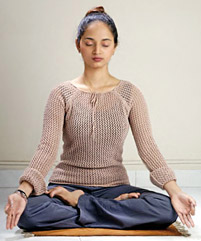 1. Assume a comfortable sitting position in a quiet place. It can be a simple cross-legged position. Keep your spine, neck, and head aligned with each other. Rest your hands on your knees, with the thumb of each hand lightly touching the tip of the forefinger. Gently close your eyes, but do not squeeze them shut.
1. Assume a comfortable sitting position in a quiet place. It can be a simple cross-legged position. Keep your spine, neck, and head aligned with each other. Rest your hands on your knees, with the thumb of each hand lightly touching the tip of the forefinger. Gently close your eyes, but do not squeeze them shut.
2. If the cross-legged position is uncomfortable, sit on a wooden chair. Make sure your trunk, neck, and head are erect and firmly place your feet flat on the floor. Whatever position you take, it must include a straight back, aligned with the neck and head in a comfortable position, and easy breathing.
3. Sit still steadily and do not move. When your body moves, your mind moves, and vice versa, since the mind and the body are one. Be aware of your body sitting still, motionless, and relaxed. Make sure that your sitting position is still comfortable, relaxed, and steady.
4. Now relax all your muscles. Visualize and allow all your muscles to relax, to become soft, loose. Start from the top of your head, and visualize and relax the muscles of your forehead, the muscles around your eyes, mouth, the facial muscles, and the muscles of your neck, shoulders, arms, and hands. Go progressively through each part of your body. Relax muscles of your chest, back, the abdominal muscles, and the muscles around your hips and pelvis the muscles of your thighs, knees, calves, and feet. Scan your body and if you notice any tension, just flow relaxation to this area as you quietly exhale. You can repeat this procedure one more time.
5. Take more deep, comfortable breaths and attune to your body. Sit still quietly - this steady, relaxed position will still and calm your body. You will become aware of different physical sensations like twitches or heaviness.
6. Sitting still will help you develop breath awareness and concentration, control thoughts and emotions, and eliminate external distractions. Later, you will also use this position to practice yoga breathing, concentration, and meditation.
Besides sitting still steadily, practicing a few yoga postures will also help the athletes gain more control over their body. Various asanas like the Paschimottanasana and the Modified Paschimottanasana can be practiced after sitting still steadily. However, one can choose any yoga posture for this purpose. Learning sitting still is very important. Athletes can move to the next step only after mastering sitting still and calming their body.
II. Breath Awareness - Control through Yoga Breathing Exercises
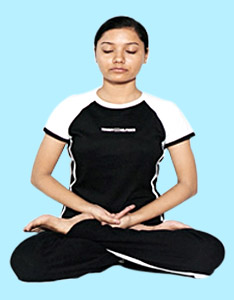 After learning sitting steadily and calming the body, the next step is learning to control one`s breath - breath awareness. This is an extremely important technique. It is always breath awareness and breathing exercises, due to which a person can control his mind, mental state, and emotions. Breath is the bridge between the body and mind. Yoga breathing is a powerful tool. The ultimate goal of most of the yoga breathing exercises is to regulate the mental state by favorably influencing the nervous system. Yoga breathing techniques facilitate concentration and meditation. Through yoga breathing you will gain conscious control over unconscious activities of the autonomic nervous system.
After learning sitting steadily and calming the body, the next step is learning to control one`s breath - breath awareness. This is an extremely important technique. It is always breath awareness and breathing exercises, due to which a person can control his mind, mental state, and emotions. Breath is the bridge between the body and mind. Yoga breathing is a powerful tool. The ultimate goal of most of the yoga breathing exercises is to regulate the mental state by favorably influencing the nervous system. Yoga breathing techniques facilitate concentration and meditation. Through yoga breathing you will gain conscious control over unconscious activities of the autonomic nervous system.
1. Steadily position after stilling, calming your body (body awareness), focuses your attention on your breathing. Observe, visualize and mentally follow your smooth, deep diaphragmatic breathing. Changes of mental state, changes of feeling, changes of bodily sensations, and postures are registered immediately in the pattern of breathing. For example, fear and anger produce shallow breathing; sorrow produces uneven, spasmodic breathing. Positive emotions create regular produces uneven, spasmodic breathing. Positive emotions create regular breathing. Every change of mental state is reflected in the breath and also in the body. This is also true in reverse - by changing the breathing pat- tem we can also alter the emotions.
III. Focusing the Attention
Training your attention is a precondition for concentration. Where you are physically present, you should also be mentally present. The first step in training your attention is to practice giving your full attention to each of your daily affairs. For example, when studying, become fully absorbed. When resting, or practicing your sport, do it with full attention. Attention can be involuntary, which means that it is based primarily on reflex. When you reflexively attend to something, it occurs spontaneously and does not require effort. For example, when you hear a fire truck`s siren, you may immediately look to see where it is coming from, without thinking about it.
Voluntary attention, on the other hand, requires self-discipline. By your own will or effort, you voluntarily direct your attention toward an object or idea. Voluntary attention requires determination and practice. Self-discipline means that you pay full voluntary attention to what you are doing. Determine to do everything with full attention. The human mind tends to wander rapidly. Concentrative analyses of top athletes performances demonstrate how overpowering mental thoughts can be, especially in stressful situations.
It is difficult for an athlete to maintain focus without learning to control and calm the mind and concentrating on breathing and in addition, for practicing attention and concentration, they usually practice one or two asanas to practice, as a part of their warm up routine and concentrate as they execute it. Although these exercises take only 2 to 5 minutes, athletes find them useful in shifting themselves from the usual state of awareness to a more focused concentrative state. The exercises serve to get the athlete mentally attuned for the upcoming practice or competition.
IV. Developing Concentration
Concentration is the most important mental skill; hence one should always focus his attention on whatever he is doing. Lack of concentration is the main reason, for negative thinking and it is the main reason behind all mental errors. Body and breath awareness exercises help in heighten the concentration. The latter should be passive and effortless and the same should be attained without too much of effort. The only way to increase one`s attention skills and minimize distracting thoughts is to practice the body and breath awareness asanas regularly.
Concentration during Competition: Keeping the mind focused under the high pressure that occurs during a competition is not an easy task, since the mind constantly wanders. During a tournament many athletes are not concentrating on the present; their mind might go back to the past or to the future - thinking about the result of the performance and the consequences of that result. Most athletes think too much during their competitions and try too hard to control their movements. Emotions, worry and concern about the result are serious obstacles to the concentration.
Regular daily practice of concentration will increase your ability to concentrate on the task at hand even under the high pressure of a competition. One of the most effective means for increasing your ability to concentrate is meditation. Athletes claim increased focus and alertness as a result of practicing meditation. Again, the preferred objects of meditation are breathing, or a mantra. During the competition you must control your thought or your thought will control you. A successful performance (game, match, bout) requires focus on the task at hand on one touch, game, etc., at a time. You should have a race or game (competition) plan, performance routine to enhance your concentration and your performance. This will provide you with a framework (time table) of specific things to focus on.
Breathing can also act as a universal object of concentration. This can enhance any sport, such as golf, basketball, baseball, tennis, football, fencing, and martial arts, as well as sports such as skiing and swimming. Using breathing as an object of concentration means focusing on the flow of breath, on the inhalation and exhalation. You may shift your mind onto your breathing during the nonaction phases of the competition in order to maintain mental focus. (Breathing is also a helpful tool in combating anxiety, which plays a big part during tournaments, and which can cause your mind to wander.)
In all sports, breathing is an important and effective means of refocusing, centering, and regaining and maintaining mental balance. Concentrative analysis of performances showed that athletes many times need just to be more conscious of things, thoughts, and self-talk they use when performing their best and to use cues to trigger their focus of attention. Thus, be aware of:
•Focusing on one thing at the critical moment.
•Focusing and being always in the present.
•Not dwelling on your mistakes.
•Developing the ability of selectively attending to critical clues.
Thus, yoga asanas can be used for different purposes and the four basic steps on the road to self-control. These four basic steps ultimately lead to meditation and ultimately to self-control. The exercises of these steps, as well as the asanas described, are not difficult. It is more difficult to make the commitment and to practice regularly than to execute the exercises. It is necessary to be aware that only regular practice will produce the desired effect. Even the most effective yoga exercise or mental skill cannot produce any effect without regular practice.
Thus, one needs to practice them daily and regularly. In yoga, the essence is, in fact, to develop a healthier lifestyle - transformation. The "big secret" of yoga is that it changes and normalizes the incorrect way of life. Yoga exercises can be effective only if you practice them regularly and in such duration that it can compensate (balance) the negative effect of an unnatural way of life which became a general lifestyle. Yoga body postures and exercises were developed to supplement and balance (compensate) the one-sided lifestyle. Thus, from the athlete`s aspect, yoga is very significant.
